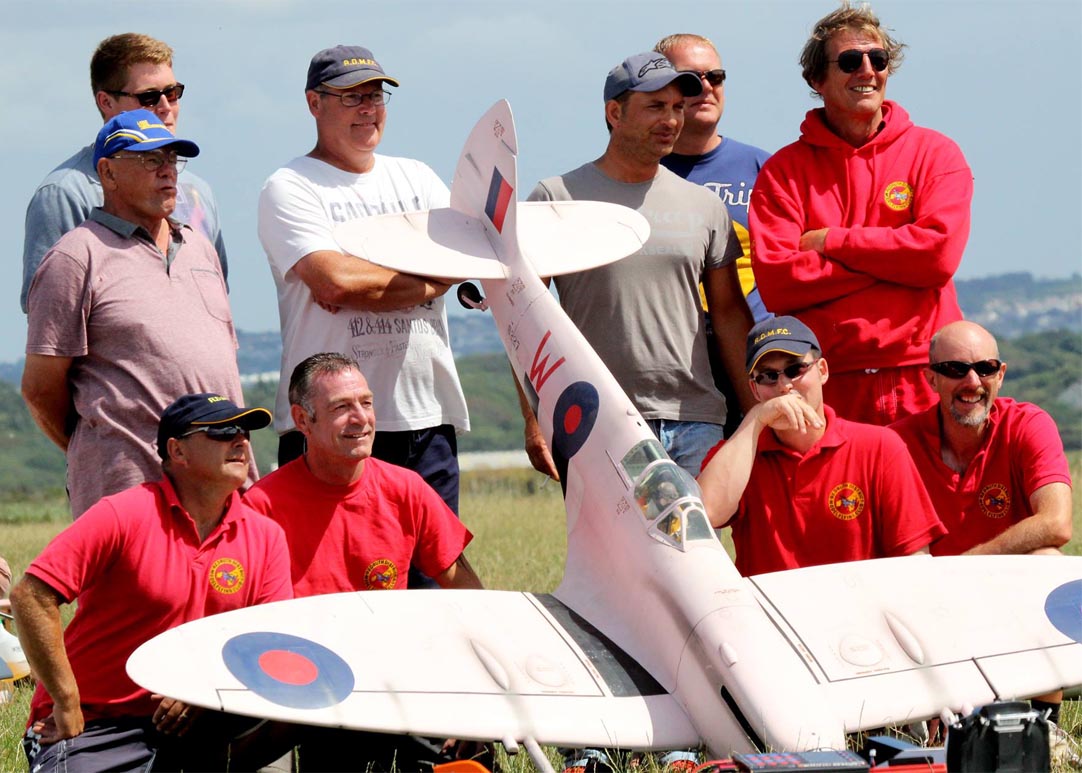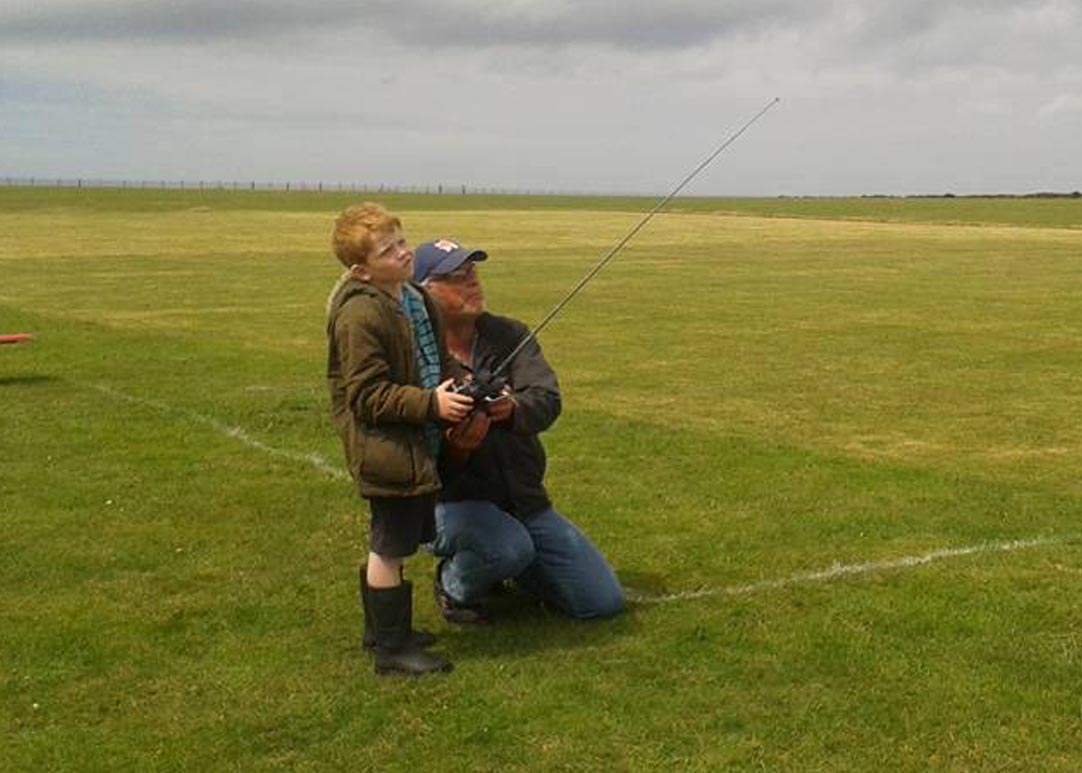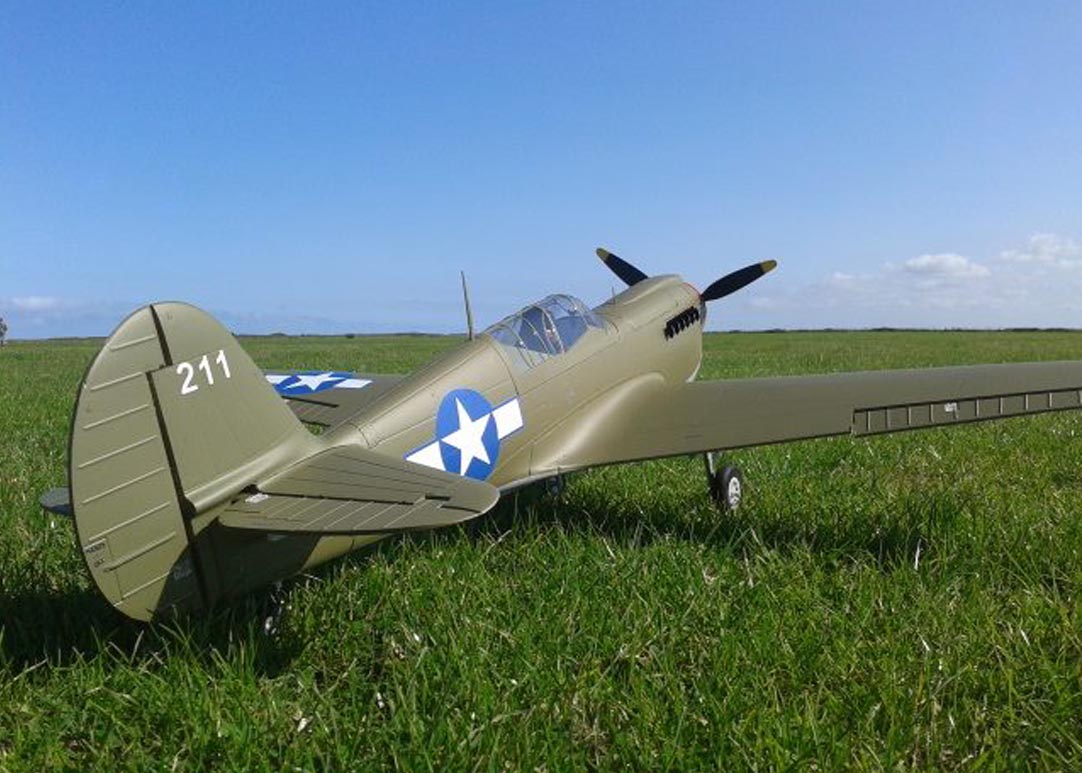Beginner Q&A
Interested in becoming a flyer? Want to know how best to begin?
The best place to start is by going to meet the club and the flyers either at the North Cliffs field and at our Monthly meetings. Our club members are more than willing to give you plenty of invaluable advice or show you want it's all about. If you are still interested then join us!
It is a requirement in this country to use 35MHz or 2.4 GHz frequency range for flying, so a transmitter and receivers must meet one of these specifications. Within this 35 MHz frequency range a channel needs to be selected. This ranges between channels 55 and 90, and a crystal fitted into your transmitter and one in the receiver in the plane must match, so they can transmit and receive a signal between the plane and the transmitter and thus communicate with each other.
A typical trainer model usually flies in the neighbourhood of 60mph (96kmph). More advanced stunt models will fly a little faster, at about 80 to 100mph (l28kmph-l60kmph) and for the expert, RC racing models often fly at 140mph (224kmph) or more.
Modern radio control systems have a range of 1 or 2 miles (2 or 3 km). However, it is very rare that a model airplane is ever flown that far away. A model with a wingspan of 5 or 6 feet (2m) will become a small speck in the sky at 1/2 mile out, so you will rarely fly at that distance because it is almost impossible to see what the model is doing and therefore know the direction. Most RC flyers keep their models within 200 or 300 yards (180 or 270 m) of themselves.
No you do not need a licence but you should ensure that you are insured against third-party claims. Insurance can be arranged either through the BMFA directly or through your local flying club for approx £35 per year. As a club we offer membership and insurance as an Annual Fee.
Beginners would also find computer flight simulators very helpful. There are a number of purpose designed systems on the market which plug into the back of a standard PC, and these use either your own RC transmitter, or a dedicated controller to give a realistic simulations of flying model helicopters and planes. By using these simulators the beginner is able to advance quite quickly because this allows practice at home without worrying about the weather or expensive repair bills!
Many flyers make use of simulators for fun or practice. Whilst they don't make up for the real thing they do help with some of the basics, like reversed controls when flying towards you.
If you are thinking of learning to fly helicopters, then a simulator is a very good place to start.
Whilst most simulators can be controlled with the keyboard/mouse/gamepad or joystick, the ultimate controller is of course your very own transmitter. Leads can be purchased or made up to suit your brand, just remember to remove the crystal before turning it on!
The second reason for an instructor is to correct any mistakes you might make when you take over the controls for the first time. Let the instructor get the model airborne and flying level at a safe altitude (several mistakes high as the old saying goes) before he/she turns the control box over to you. You will quickly find out that it is very easy to over control an RC model and to get disoriented- Everyone does it at first! If you get into serious trouble on your first flight, quickly hand the transmitter back to the instructor so he/she can rescue the airplane.
In addition to not over controlling, another problem that beginners need to overcome in learning RC is the left/right control reversal that happens when the model is flying towards you one minute, away from you the next. Its not that learning to fly RC is difficult, its just a lot different than anything you have ever done before. Anyone can learn to fly RC airplanes if they are willing to listen and learn remember the first time you tried to ride a bicycle? It seemed completely awkward the first time, but once you learned how, it quickly became very easy. Learning to fly an RC model airplane also comes quickly to most people. Fly your trainer as often as you can, until you have it completely mastered. After you get a few flights under your belt with an instructor at your side, you will begin to feel more comfortable at the controls. Soon you will be flying by yourself with little thought to the move required. It will just come naturally. Dont get discouraged if you have a minor rack-up; repair the damage and get back into the air as soon as possible. As your reflexes become trained to RC flying, you will soon be able to adapt to the faster flight of more aerobatic models.
The best instructional method uses a Buddy Box. A Buddy Box setup requires two similar transmitters hooked together with a lead. This allows the instructor and the student more time to recognize and correct mistakes. These allow the instructor to take control back quickly from you, similar as to how an instructor can control a vehicle when people learn to drive.
Fixed Wing Aircraft are those that are powered using a range of motors and types. You will normally train on a high-winged RC plane because these allow you to build up your skills and confidence in the hobby before you move to other types of RC models.
This group of planes will also include the 'Sport' and 'Aerobatic' planes which tend to have mid to low or low wings respectively. 'Scale' aircraft also fall into this category.
There is however one aspect of flying which does away with noise – namely a glider. Gliding has been very important to the development of flight. The early pioneers, such as, Otto Lilienttal and the Wright Brothers, learned both the theory and the practicalities of flight with gliders, before they attempted to start an engine.
Thermal Gliders
Without an engine, any aircraft will start to descend, some quicker than others. The only way to remain airborne is to find a column of air which is rising more quickly than the aircraft is descending. These columns of air are found either as a slope lift, where the wind blows up the face of a slope, or a thermal a column of hot air which is found over such places as roads, heating towers etc.
Model gliders designed to make use of thermals usually have a wing span of between 6 and 15 feet and can weigh up to 10 Lb. Theyre launched by a towline, up to a height of 500 ft, after which the pilot uses radio controls to guide the aircraft around the sky in search of the elusive thermals. Flight duration is between 5 and 15 minutes, however, the British record is over 3 hours.
Slope Soarers
The other types of gliders, which are most commonly used by club members, are slope soarers. Here lift is obtained where a steady wind meets a hill or a cliff and has to rise to go over it. Here in Cornwall we have an abundance of cliffs and wind, so this form of gliding is very popular, model types are extremely varied, ranging from 3ft to l5ft, some are very aerobatic. Scale models look particularly graceful. There are not only scale models of gliders but also of jet fighters, World War II aircraft and many others. The flight will last as long as the wind is moving, so with a suitable receiver battery this means anything up to 3 hours.
Slope soaring is an easy way of learning to fly radio controlled aircraft. There is no noise, no fuel to clean off the model and flight times are not limited to the size of your fuel tank. As long as the wind blows and you can feel you fingers, then you can fly!
Radio controlled helicopters represent a growing sector of the Redruth and District Model Flying Club and are a fascinating and challenging part of our hobby. This is partly because of their mechanical complexity and partly because of their flying characteristics, which are quite different from those of fixed-wing aircraft, and therefore require different piloting techniques. Model helicopters are now available in a wide range of types and sizes, ranging from tiny electrically powered indoor models to large jet turbine powered machines. They also find use in commercial and industrial applications such as photography and cable-laying. They all have a basically similar mechanical layout and when flying, are controlled in the same way as full size helicopters.
For anyone interested in starting in this branch of the hobby, there is currently a good selection or suitable training machines produced by various manufacturers, at reasonable prices, such models are quite straightforward to assemble, but we would always recommend that you have your new model checked out and test flown by an experienced helicopter flyer.
The BMFA operates a certificate system for both fixed wing and helicopter RC models. For more information about the certificates and what actions must be carried out to meet the certificate requirements click here.

.JPG)






